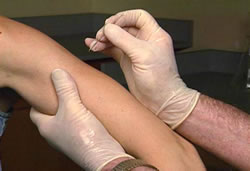SMALLPOX FACT SHEET – Information for Clinicians
Smallpox Vaccination Method
Multiple Puncture Vaccination
 |
| View enlarged image. |
During the global smallpox eradication effort, the bifurcated needle was used along with a technique called multiple puncture vaccination. Today, this is still the recommended method for administering smallpox vaccine.
Each bifurcated needle is sterile and individually wrapped. The bifurcated needle is for one-time use only and should be discarded in an appropriate biohazard container immediately after vaccinating each patient.
Step-by-Step Instructions
- Review
patient history for contraindications.
- Choose
the site for vaccination.
The deltoid area on the upper arm is recommended.
- Skin
preparation.
No skin preparation is required. Under no circumstances should alcohol be applied to the skin prior to vaccination as it has been shown to inactivate the vaccine virus.
- Dip
needle.
The needle is dipped into the vaccine vial and withdrawn. The needle is designed to hold a tiny drop of vaccine of sufficient size and strength to ensure a take if properly administered. The same needle should never be dipped into the vaccine vial more than once, in order to avoid contamination of the vaccine vial.
- Make
perpendicular insertions within a 5-mm diameter area.
The needle is held perpendicular to the site of insertion. The wrist of the vaccinator should be maintained in a firm position by resting on the arm of the vaccinee or another firm support.- A number of perpendicular insertions are made in rapid order in an area approximately 5 mm in diameter. The number of insertions should be in accordance with the package insert, using 15 insertions for all vaccinees. A trace of blood should appear at the site of vaccination within 15-20 seconds.
- The
bifurcated needle is for one-time use only and should be discarded
in an appropriate biohazard container immediately after vaccinating
each patient.
- Absorb
Excess Vaccine
After vaccination, excess vaccine should be absorbed with sterile gauze. Discard the gauze in a safe manner (usually in an infection control receptacle) in order not to contaminate the site or infect others who may come in contact with it.
- Cover
vaccination site.
It is important that the vaccination site be covered to prevent dissemination of virus. Recommended coverings include the following:- Gauze loosely secured by first aid adhesive tape (taking care to obtain history of tape sensitivity).
- When working in a health care setting, vaccinees should keep their vaccination site covered with gauze or a similar absorbent material. This dressing should, in turn, be covered with a semipermeable dressing. Products combining an absorbent base with an overlying semipermeable layer also can be used to cover the vaccination site. Healthcare workers do not need to be placed on leave after receiving a smallpox vaccination.
- Vaccinees in settings where close personal contact is likely (such as parents of infants and young children) should cover the vaccination site with gauze or a similar absorbent material, wear a shirt or other clothing that would cover the vaccination site, and also make sure to practice good hand hygiene.
Note: The use of semipermeable dressing alone could cause maceration of the vaccination site and increased, prolonged irritation and itching at the site, thereby increasing touching, scratching, and contamination of the hands. Thus, only persons working in healthcare settings should use semipermeable dressings (over gauze or a similar absorbent material as described above).
- Educate
vaccinee.
To avoid contact transmission of the virus, vaccinees must be cautioned to do the following:- Do not rub or scratch the vaccination site.
- Keep the site covered and change gauze-only dressings every 1-2 days or if wet. Change semipermeable dressings at least every 3-5 days.
- Keep the vaccination site dry, covering it with a water-proof bandage while bathing.
- Discard gauze carefully in plastic zip bags.
- Set aside a laundry hamper for clothes, towels, sheets and other items that may come into contact with the vaccination site.
- Wash clothing or other materials that come into contact with the vaccination site in hot water with detergent and/or bleach. Wash hands afterward.
- Wash hands thoroughly with soap and hot water or with alcohol-based hand rubs such as gels or foams after touching the vaccination site, or bandages, clothing, towels, or sheets that have come into contact with the vaccination site.
- When the scab falls off, throw it away in a plastic zip bag.
- Report any problems by calling the phone number provided on the "Post-Vaccination and Follow-Up Information" sheet, calling your health care provider, or visiting and emergency room.
- Return
7 days after vaccination for a “take” check (to see
if the vaccination was successful).
- Record
the vaccination.
Record vaccination information as instructed by the CDC.
- Page last reviewed February 7, 2007
- Page last updated February 12, 2003
- Content source: Division of Bioterrorism Preparedness and Response (DBPR), National Center for Preparedness, Detection, and Control of Infectious Diseases (NCPDCID), Coordinating Center for Infectious Diseases (CCID)
Get email updates
To receive email updates about this page, enter your email address:
Contact Us:
- Centers for Disease Control and Prevention
1600 Clifton Rd
Atlanta, GA 30333 - 800-CDC-INFO
(800-232-4636)
TTY: (888) 232-6348
24 Hours/Every Day - cdcinfo@cdc.gov

